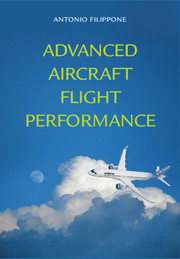Book contents
- Frontmatter
- Contents
- Tables
- Preface
- Nomenclature
- Technology Warning
- 1 Prolegomena
- 2 Aircraft Models
- 3 Weight and Balance Performance
- 4 Aerodynamic Performance
- 5 Engine Performance
- 6 Propeller Performance
- 7 Airplane Trim
- 8 Flight Envelopes
- 9 Take-Off and Field Performance
- 10 Climb Performance
- 11 Descent and Landing Performance
- 12 Cruise Performance
- 13 Manoeuvre Performance
- 14 Thermo-Structural Performance
- 15 Mission Analysis
- 16 Aircraft Noise: Noise Sources
- 17 Aircraft Noise: Propagation
- 18 Aircraft Noise: Flight Trajectories
- 19 Environmental Performance
- 20 Epilogue
- Appendix A Gulfstream G-550
- Appendix B Certified Aircraft Noise Data
- Appendix C Options for the FLIGHT Program
- Index
- References
7 - Airplane Trim
Published online by Cambridge University Press: 05 January 2013
- Frontmatter
- Contents
- Tables
- Preface
- Nomenclature
- Technology Warning
- 1 Prolegomena
- 2 Aircraft Models
- 3 Weight and Balance Performance
- 4 Aerodynamic Performance
- 5 Engine Performance
- 6 Propeller Performance
- 7 Airplane Trim
- 8 Flight Envelopes
- 9 Take-Off and Field Performance
- 10 Climb Performance
- 11 Descent and Landing Performance
- 12 Cruise Performance
- 13 Manoeuvre Performance
- 14 Thermo-Structural Performance
- 15 Mission Analysis
- 16 Aircraft Noise: Noise Sources
- 17 Aircraft Noise: Propagation
- 18 Aircraft Noise: Flight Trajectories
- 19 Environmental Performance
- 20 Epilogue
- Appendix A Gulfstream G-550
- Appendix B Certified Aircraft Noise Data
- Appendix C Options for the FLIGHT Program
- Index
- References
Summary
Overview
The problem of airplane trim involves the determination of the control requirements to maintain a stable flight or to perform specified manoeuvres. The position of the centre of gravity (CG) is essential, and some consideration is given to this effect on the cruise flight. In this chapter we consider the problem of static longitudinal trim (§ 7.1), lateral trim and airplane control under asymmetric thrust (§ 7.2). We consider only steady-state conditions. Transient conditions are the subject of flight dynamics and therefore are not considered in this chapter.
KEY CONCEPTS: Longitudinal Trim, Trim Drag, Stick-Free Trim, Thrust Asymmetry, Lateral Control.
Longitudinal Trim at Cruise Conditions
The airplane in free flight is subject to a number of forces that must be balanced to ensure steady-state flight. In the following analysis, cruise condition is a term that is extended to the airplane climbing and descending, subject to the airplane being in clean configuration. We consider the role of the tail-plane and the elevator in providing longitudinal control (longitudinal trim). Because the wing lift and the CG are not at the same point, the airplane will have a nose-down or nose-up pitching moment.
Although the CG is generally on the vertical symmetry plane, neither the propulsive forces nor aerodynamic forces are on that plane. To begin with, we assume that the contributions from engines and wings are symmetric, so that it is possible to reduce the problem to a balance of forces and moments in one plane.
- Type
- Chapter
- Information
- Advanced Aircraft Flight Performance , pp. 179 - 194Publisher: Cambridge University PressPrint publication year: 2012



